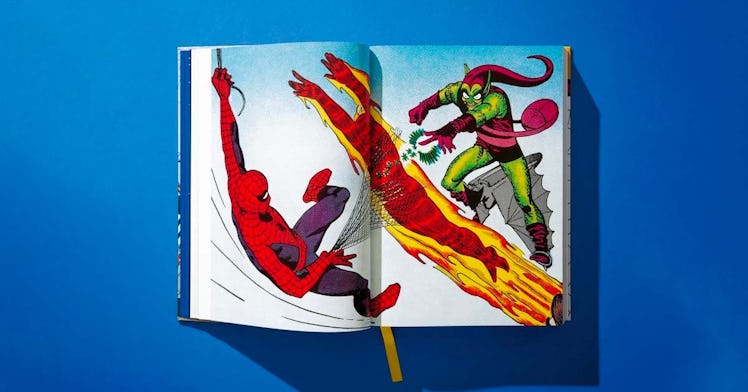Loved ‘Spider-Man: No Way Home’? Read These Comics Next
Welcome to the real Spider-Verse.

The fever-dream of Spider-Man: No Way Home is finally here. All the leaks were true, but the way all the old-school nostalgia played out isn’t anywhere close to what we expected. It’s the most surprising crossover superhero movie in years, and also seems to tease maddening connections to other franchises thanks to crossing timelines and an over-the-top post-credits scene.
But, is any of this based on the Marvel comic books? If you’ve got an older kid, which of the Spider-Man comics should you hit up?
To e clear No Way Home isn’t based on any single specific comic–it’s a story that builds off of the last two movies Holland did after Avengers: Civil War. However, there are three excellent comic collections that you should dig into if you’d like to experience how this whole idea of multiple Spider-universes–and spider-people– took shape. Mild spoilers ahead!
SPIDER-MEN (2013)
Spider-Men is a great place to start messing about with the spider-verse. Bendis and Picheli’s 2013 mini-series is not only a great story—to be expected with writer Brian Michael Bendis and artist Sara Pichelli at the top of their A-games—but it helpfully only involves two universes. In the Marvel Universe, the “regular,” known—or prime—universe is called Earth 616: this is where most all the stories we’ve come to know as “real world” Marvel stories take place. Spider-Men kicks-off with Peter Parker stumbling upon the villain Mysterio—a mad scientist type with fishbowl helmets and android avatars, de rigeur—messing about with an inter-universe portal. In their melee, Peter gets flung into another universe.
The rest of the series involves Peter making sense of a world where not only does everyone know that Peter Parker is Spider-Man—but this other universe’s Peter Parker is dead! The real fun surrounds Peter encountering this universe’s version of Spider-Man: the teenager Miles Morales. Miles had been introduced in another series by Bendis and Picheli, but Spider-Men is the first time Peter and Miles meet up. While Peter grapples with the impact that the death of this universe’s Peter had on Aunt May and friends Gwen and MJ, Miles is given the chance to meet the (for him dead) hero who he set out to honor. Bendis and Pichelli’s story is a great introduction to how these characters navigate the realization of the existence of this multiverse, and how their fates play out similarly and wildly divergently. Oh: and we get to see the “Ultimate universe” version of the Avengers—including a Nick Fury who, unlike the 616 version, bears a striking resemblance to a certain actor who plays him in the MCU.
SPIDER-VERSE (2014)
Your next stop should be Spider-Verse: and it’s a trip. At 600-some pages, this collection draws together the 2014 crossover event that cracked open the multiverse even wider to a seemingly endless array of spider-folk. The evil vampiric Inheritors have begun to hunt down spider-people across different dimensions—and it’s left to Peter Parker, Miles Morales, and a gang of other spideys to try to stop them.
The premise is established in the opening pages, a family of vampires is hunting down spider folk across time and space. After dispatching an Elizabethan “Spider,” one such vampire consumes “the great spirit that dwells within” the spider. There is a “web” (yes, they lean pretty heavy into the spider-stuff in this spider-verse) of spider-people and all the “threads in the web shall be severed” if these Inheritors have their way. In the far future of 2099, we’re introduced to “Superior Spider-Man,” a version of the character where the mind of Otto Octavious (Doc Ock) is fused into the body of Peter Parker. (Got that? Things get weird in comics, so prepare yourself.) Superior Spider-Man accidentally discovers the existence of some force hunting down alternate dimension Spider-folk, and embarks “on a quest to raise an army of Spider-men to fight against this creature.” Now, it’s rare, I think, that such a gonzo idea (a spider-verse of spider-folk hunted by a vampire family hungry for spider-energy) to get played out coherently and with marvelously controlled comics magic. The double-page spread where Pavitr Prabhakar, Six-Armed Spider Man, Spider-Man Noir, Ashley Spider-Girl Barton, Spider Monkey (a genetically altered Peter Marker-monkey combo, because: of course), Assassin Spider-Man, and Superior Spider-Man show up to help a Cyborg Spider-Man on the East Side Yards of Manhattan on Earth 2818 is just fantastic business. And yes: Miles Morales and Earth 616 Peter Parker show up to lend a hand, plus a whole slew of other fun variations. While we’re no doubt in for some great multiverse-shenanigans in No Way Home, this extended series—featuring an array of writers and artists—turns the premise up to 11 — and it’s great damn fun.
The Marvel Comics Library. Spider-Man. Vol. 1. 1962–1964
Out from Taschen as of this December, this amazing volume chronicles the very beginning of Spider-Man in 1962. Although the multiverse action wasn’t embedded into the beginnings of Spidey, his personality from the start remains infectious and upbeat.
The power of reading the old Spidey comics, especially with a younger reader, is all about seeing how much has changed and how much has stayed the same. If you’re looking for something that a very young fan can enjoy, but that’s also a beautiful collector’s item, you can’t go wrong with this book. We loved Taschen’s new James Bond book, and this Spider-Man volume is just as good.
Spider-Man: No Way Home is playing in theaters now.